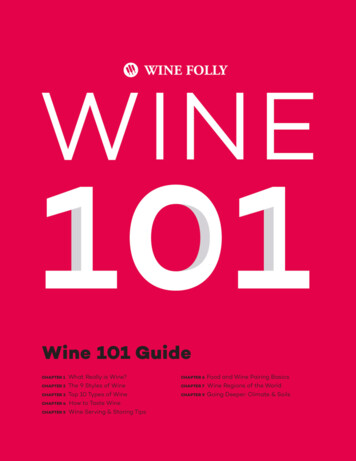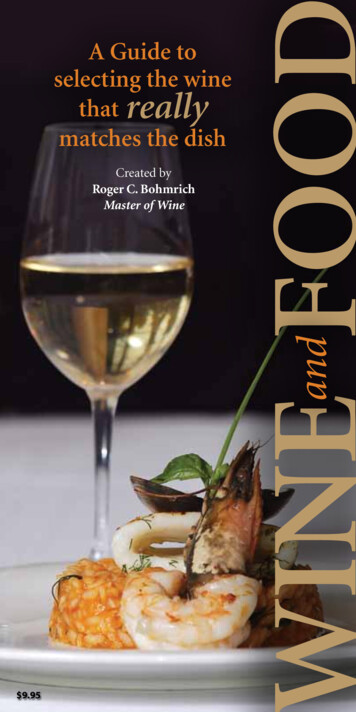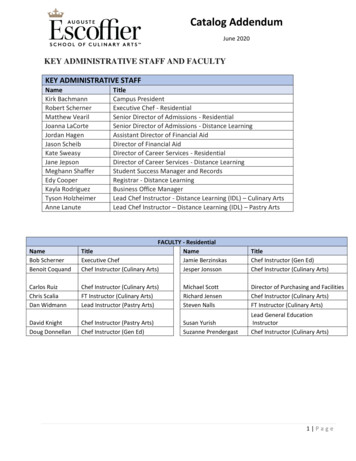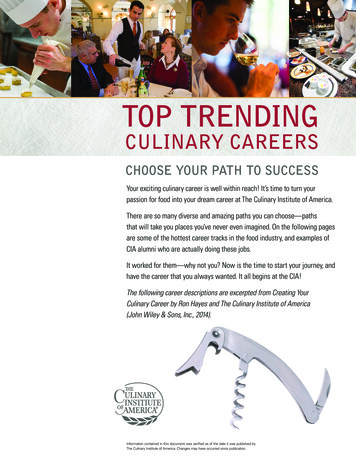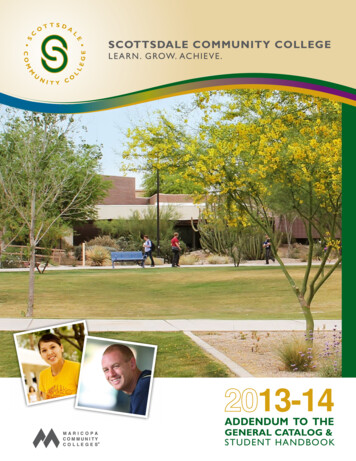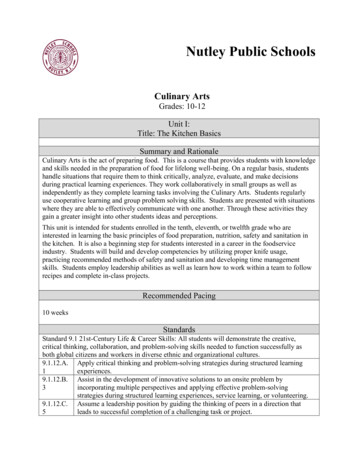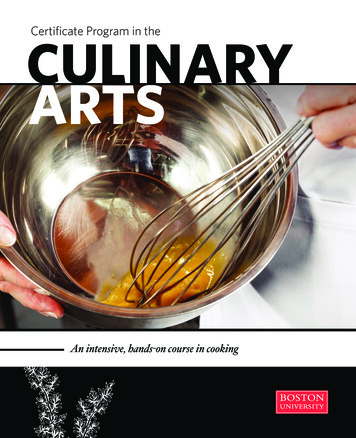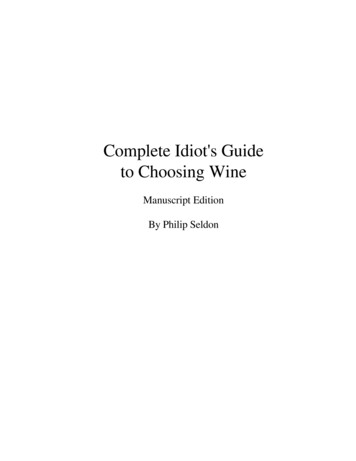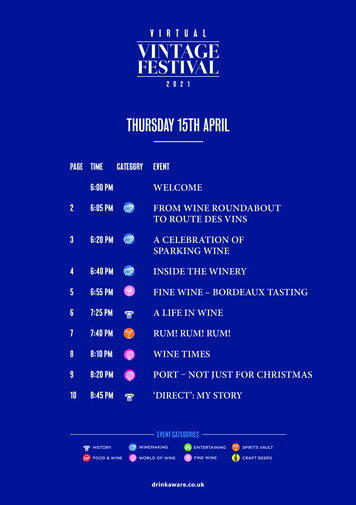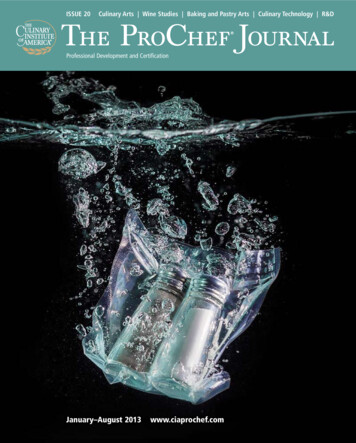
Transcription
ISSUE 20Culinary Arts Wine Studies Baking and Pastry Arts Culinary Technology R&DThe ProChef Journal Professional Development and CertificationJanuary–August 2013www.ciaprochef.com
TABLE OF CONTENTSJOURNALNEWSFeaturesYour Intuition Most Likely Fails YouIt All Started with 12,000 FrancsPrecision CookingTextureSous Vide and Food SafetyOne Lump or Two?Spring Easter BreadsBiodynamic ViticultureLeadership and Innovation forthe Professional ChefGet Social!The Story of StorycellarsThe Power of ProChefEmbracing Sous VideCaptivating Confections303238415582Certifications and CoursesCourse CalendarRequired Skill LevelsProChef Certification ProgramProChef Level I CoursesProChef Level II CoursesProChef Level III CoursesWorld Cuisine CoursesCulinary Technology CoursesSpecialized and Advanced CoursesBaking and Pastry CoursesMenu R&D Online CoursesProfessional Wine Studies and Certification3642444750525456586061customed to and may initially resist. But the paradigm shiftTraining Materials and TextbooksRegistration and Course InformationAbout the CIA748991we’re doing in the kitchen, books filled with revolutionary811121516222528Brad Barnes ’87, CMCSenior Director—Continuing EducationThe impact of sous vide and precision temperature cookingon our industry has been nothing short of profound. It’s truethat the concept requires cooks to generate a tremendousamount of documentation, something we are typically unac-The ProChef JournalDecember 2012, Issue 20Published by The Culinary Institute of America1946 Campus Drive, Hyde Park, NY 12538-1499in the areas of operational intelligence, systems, and procedures is a real positive for our industry. The need to work ina more controlled environment pushes us to strive for standardization. It also opens new doors for creativity andexploring the way food reacts to heat.Along with the advent of these recent changes, the past 10years have been a time for some of the age-old practices ofcooking to be questioned and challenged. Whether it hasbeen through endless restaurant notes documenting whatnew ideas, or the calculated creativity of many of today’sincredible culinary talent, we have teased ourselves into aserious exploration of our craft. And we are emergingstronger, more concise, and better positioned to go whereno cook previously would dare to go.Photography: Roger Ball, Faith Echtermeyer, Keith Ferris, Ben Fink,Phil Mansfield, Terrence McCarthy, Chas McGrath, PolyScience,Anne Rettig, Antonio Tahhan, David Wakely, and Michael WhiteThis cutting-edge work that is driving cooking to new places 2012 The Culinary Institute of Americaand continuing education programs. Stay tuned, folks. Theis already happening at the CIA in our degree, consulting,best is yet to come in the world of food.HOW TO REGISTERWEB: Visit www.ciaprochef.comPHONE: Call 1-888-851-3313FAX: 845-451-1078MAIL: Accounts Receivable, The Culinary Instituteof America, 1946 Campus Drive, Hyde Park, NY12538-1499IN PERSON: See a Continuing Education customerservice representative at our New York, California, orTexas Campuses.PLEASE NOTE: Course availability, dates, and timesare subject to change. For the most up-to-date classinformation, please visit www.ciaprochef.com.2 1-888-851-3313WE’RE HERE TO HELPDo you have questions about our courses, ProChefCertification, or your professional developmentgoals? We’d love to hear from you!Brad Barnes, CMC, senior director—continuing educationb barnes@culinary.edu or 845-451-1613Diana Delonis, director—education supportd deloni@culinary.edu or 707-967-2497David Kellaway, CMC, managing director—CIA, San Antoniod kellaw@culinary.edu or 210-222-1113
JANUARY 7MARCH 13St. Helena, CA CampusThe Business of Wine: Understanding the Pipelinefrom Producer to Consumer (p. 68)St. Helena, CA CampusThe Business of Wine: Understanding the Pipelinefrom Producer to Consumer (p. 68)DID YOU KNOW?JANUARY 14MARCH 18in the ProChef Certification CoursesSan Antonio, TX CampusGlobal Street Food: From Street to Table AM (p. 57)St. Helena, CA CampusMastering Wine I (p. 67)sections of this publication. TheseJANUARY 22MARCH 20advanced-level courses are open toSan Antonio, TX CampusTechniques of Healthy Cooking AM (p. 49)St. Helena, CA CampusCoffee Expert: From the Plant to the Cup (p. 72)all foodservice professionals. CheckJANUARY 28MARCH 25and on pages 44–51.San Antonio, TX CampusMediterranean Cuisine: Ingredients and TechniquesAM (p. 49)St. Helena, CA CampusMastering Wine II (p. 67)FEBRUARY 4St. Helena, CA CampusIntroduction to the Classic Wine Regions of Europe I(p. 68)San Antonio, TX CampusBaking and Pastry for Chefs: Desserts and Breadsfrom the Hot Kitchen AM (p. 48, 58)FEBRUARY 11St. Helena, CA CampusCareer Discovery: The Professional World of Wine(p. 66)The Cooking of Italy: From Tuscany to Sicily PM (p. 52)San Antonio, TX CampusSous-Vide Cooking AM (p. 54)APRIL 1APRIL 4St. Helena, CA CampusIntroduction to the Classic Wine Regions of Europe II(p. 68)them out at www.ciaprochef.comAPRIL 8St. Helena, CA CampusWine and Food Pairing Fundamentals (p. 73)APRIL 11St. Helena, CA CampusCertified Wine Professional—Foundation Level IExam (p. 64)APRIL 29St. Helena, CA CampusCareer Discovery: The Professional World of Wine(p. 66)Global Street Foods: From Street to Table PM(p. 53, 57)Intermediate Wedding Cake Design PM (p. 58)FEBRUARY 27St. Helena, CA CampusThe California Intensive (p. 69)MAY 13MARCH 4St. Helena, CA CampusModern Plated Desserts PM (p. 59)The Rhône Intensive (p. 71)Southeast Asia: Traditional Flavors and TechniquesPM (p. 53)St. Helena, CA CampusWinemaking Basics (p. 68)Wine Immersion (p. 66)San Antonio, TX CampusThe Art and Science of Cooking AM (p. 48)MAY 14MARCH 7St. Helena, CA CampusSensory Analysis of Wine (p. 67)San Antonio, TX CampusExceptional In-Flight Service (p. 56)Garde Manger: The Art and Craft of the Cold KitchenPM (p. 49, 56)foundation-, intermediate-, andMAY 6San Antonio, TX CampusProChef Level I Certification Exam (p. 45)MARCH 11candidate to take the courses listedSt. Helena, CA CampusFire, Spice, and the Global Grill: Vibrant Dishes fromHot Climates PM (p. 52)FEBRUARY 25St. Helena, CA CampusProfessional Wine Service: A Practical Workshop(p. 67)You don’t have to be a ProChefCOURSE CALENDARCOURSE CALENDAR JANUARY–AUGUST 2013San Antonio, TX CampusProChef Level II Certification Exam (p. 48)MAY 15COURSE SATISFACTORYCOMPLETION REQUIREMENTSStudents must participate in all exercises and discussions and attend atleast 95% of the course to beawarded Continuing Education Unitsfrom the IACET. Please see page 90for more information.St. Helena, CA CampusThe Burgundy Intensive (p. 71)MAY 20St. Helena, CA CampusThe Bordeaux Intensive (p. 70)www.ciaprochef.com 3
COURSE CALENDARMAY 22JULY 3St. Helena, CA CampusChampagne in Depth (p. 69)St. Helena, CA CampusCertified Wine Professional—Foundation Level IExam (p. 64)MAY 23AUGUST 19St. Helena, CA CampusThe Napa Valley Intensive (p. 69)St. Helena, CA CampusThe Italy Intensive (p. 71)MAY 27St. Helena, CA CampusProfessional Wine Service: A Practical Workshop(p. 67)Wine Immersion (p. 66)AUGUST 21MAY 29St. Helena, CA CampusThe Spain Intensive (p. 72)St. Helena, CA CampusCoffee Expert: From the Plant to the Cup (p. 72)AUGUST 22St. Helena, CA CampusWinemaking Basics (p. 68)AUGUST 26JUNE 3St. Helena, CA CampusThe Cooking of Italy: From Tuscany to Sicily PM (p. 52)The Germany and Austria Intensive (p. 71)St. Helena, CA CampusThe Business of Wine: Understanding the Pipelinefrom Producer to Consumer (p. 68)SEPTEMBER 10JUNE 6JUNE 24St. Helena, CA CampusSensory Analysis of Wine (p. 67)St. Helena, CA CampusIntroduction to the Classic Wine Regions of Europe I(p. 68)Small Dishes, Big Flavors: Appetizers and FirstCourses PM (p. 56)JUNE 10St. Helena, CA CampusExceptional In-Flight Service (p. 56)Mastering Wine I (p. 67)Mediterranean Cooking: An Advanced Course PM(p. 53)Modern American Charcuterie AM (p. 56)JUNE 27St. Helena, CA CampusIntroduction to the Classic Wine Regions of Europe II(p. 68)JUNE 17JULY 1St. Helena, CA CampusMastering Wine II (p. 67)Techniques of Healthy Cooking PM (p. 49)St. Helena, CA CampusWine and Food Pairing Fundamentals (p. 73)St. Helena, CA CampusAccelerated Wine and Beverage Certificate Program(p. 63)Chef’s Tour of Napa Valley AM (p. 52)SEPTEMBER 23St. Helena, CA CampusModern American Charcuterie AM (p. 56)NOVEMBER 18St. Helena, CA CampusAdvanced Seafood Cooking PM (p. 57)Where Are the Hyde Park Classes?You may have noticed the lack of classes at the Hyde Park, NY campus listed in this edition of The ProChef Journal. That’sbecause the CIA is in the midst of rolling out exciting changes to our degree programs and temporarily needs extra kitchen spaceto implement them. We expect this transition period to last throughout 2013.During this time, we may occasionally have kitchens that free up and allow us to schedule some professional development classesfor you on short notice. So we encourage you to check the course listings on www.ciaprochef.com/programs frequently and subscribe to our e-news at www.ciaprochef.com/enews/subscribe.html to ensure you get all the latest updates from Hyde Park.Of course, this is also the perfect opportunity to take courses at our California or Texas campus—and at the same time, experience the food and wine culture of the Napa Valley and the vibrant flavors that abound in San Antonio.Thank you for your patience, and for choosing The Culinary Institute of America for your professional development.4 1-888-851-3313
Reignite YourPassionYou got into this industry because you’re passionate about food and beverages.And, luckily for you, in this line of work there’s always something exciting—street food,sous-vide cooking, frozen desserts, organic wines, artisan craft beers—to keep theflame burning.Spend a few days at the CIA and inject new energy into your career. You’ll stretchyour skills, connect with fellow professionals, and feel that rush of excitement anddiscovery all over again.Courses for Industry ProfessionalsCulinary Arts Baking and Pastry Arts Wine StudiesCulinary Technology R&D 2012 The Culinary Institute of de Park, NY St. Helena, CA San Antonio, TX
REQUIRED SKILL LEVELSREQUIRED SKILLLEVELSContinuing Education courses at The Culinary Institute of America are designed to provide an optimum learning environment for our students. Dailylearning objectives, learning activities, and keyterms are provided to participants on each day oftheir program. Depending on the class, readingassignments and instructor demonstrations arealso provided.To assist in choosing the Continuing Education program, courses are designated with one, two, orthree symbols, which represent the level of experience needed for that particular program.COOKING COURSESFoundationCooking Experience: Minimum of at least sixmonths in a professional kitchen or foodserviceestablishment.Knife Skills: Knowledge of the proper knife for agiven task; ability to perform various cuts—dice,julienne, paysanne, chiffonade, and brunoise.Equipment Knowledge: Working knowledge andapplication of equipment used in a commercialkitchen.Kitchen Terminology: Knowledge of professionalkitchen terms such as the components and ratio ofa standard mirepoix, and the ability to understandand apply common foodservice terminology.IntermediateCooking Experience: Ability to apply all the basicworking techniques most commonly used in a professional kitchen: sauté, braise, grill, fry, pan fry,roast, poach, vegetable, and starch cookery.Knife Skills: Proficiency in all knife cuts—dice,julienne, paysanne, chiffonade, brunoise, rondelle,tourné, and batonnets—is imperative and indispensable.Equipment Knowledge: Proficient with all commercial kitchen equipment and its usage.Kitchen Terminology: Thorough understandingof, as well as capability in, product identification.6 1-888-851-3313AdvancedCooking Experience: A high level of work experi-ence with proficiency in all cooking techniques,plate presentation, and flavor development andbalance.Knife Skills: Highly proficient; knowledge of portion control and fabrication.Equipment Knowledge: Familiar with all equipment in a commercial kitchen—convection ovensand combi ovens.Kitchen Terminology: Excellent product knowledge and use of terms for ingredients, equipment,methods, and finished products.BAKING & PASTRY COURSESFoundationBaking and Pastry Experience: Six months in aprofessional foodservice operation; comfortableoperating in a professional bakeshop or kitchen.IntermediateBaking Experience: Advanced professional experience in baking; familiar with all mixing methods;basic finishing skills such as piping and icing.Pastry Experience: Advanced professional experience in the pastry arts; familiar with all mixingmethods; basic finishing skills such as piping andicing.AdvancedBaking Experience: Proficient in all bread mixingmethods, fermentation technology, and dividing andshaping loaves.Pastry Experience: Proficient in all mixing methods; good finishing skills; able to prepare andassemble cakes, desserts, and pastries; sensibility totaste, texture, and composition of a finished item.PROFESSIONAL WINESTUDIES COURSESOur courses are most effective when matched toyour skill level. Though wine and beverages expertise is difficult to judge, please use the followingguidelines in determining the level of course workbest suited for you.FoundationStudents should have experience with tasting abroad array of wine varieties from different areasaround the world.IntermediateStudents should be comfortable giving a basicdescription of wine and its attributes and befamiliar with the names of the world’s majorgrape varieties and wine regions.AdvancedStudents should be familiar with the world’s majorgrape varieties and wine regions, possess a basicunderstanding of how wine is made, and be familiarwith the basics of wine service. Some understandingof basic viticultural concepts is a plus.
Gold Standard InnovationThe birth of a great idea pure business gold. But how do you turn raw vision into asuccessful, market-ready product that resonates with customers? Partner with us.With unmatched culinary expertise and industry know-how, CIA Consulting is yourstrategic partner in foodservice and hospitality R&D. Create new business opportunities. Reenergize your product line. Streamline your operations. Our chef-consultantswill collaborate with you at The Culinary Institute of America campuses in New York orCalifornia, or at your own location, worldwide. 2012 The Culinary Institute of Americawww.ciaprochef.com/consulting1-888-826-6931
Your Intuition Most LikelyFails YouCurveballs of Sous Vide Cooking TimesBy Christoph Milzhen cooking sous vide, precise and constanttemperature control is a major factor that challenges our intuition about cooking times. Ourexperience based on traditional cooking methods teaches usthat timing is extremely critical. To have control to 1 10th ofa degree in temperature influences dramatically how heattravels through food and how cooking relates to doneness.WYou’d probably guess that it’s twice as long, but the realityis that it takes almost 3.5 times as long to reach core. Thetime actually required to reach exact core temperature is5 hours and 36 minutes. Fifty percent of that time is needed to reach the last 1 to 2 degrees of core temperature. Inother words, after 3 hours, your 2"-thick steak will have acore temperature of 138 degrees Fahrenheit.Various factors influence cooking time, and in sous videthese factors behave in a different way than most of uswould expect. The examples in this article point out someof the most surprising cases.The explanation for this non-linear time factor is simple:The smaller the temperature difference between the waterand the surface of the beef, the slower heat travels to thecore. Simply think of the outer layers as an insulation shield.SizeIf you still follow me, you will enjoy this additional fact: Sizeis a much more important factor in cooking time than typeof protein. The rate at which heat travels through proteinslike chicken, beef, lamb, or fish has very little variance. In away, this is helpful to know, because it means that the nextquestion can be applied universally to any food.Let’s say you set up a typical sous-vide bath, which is setand controlled at the same temperature as the desired coretemperature of the food. If it takes 1 hour and 39 minutesto cook a 1"-thick piece of beef steak to a core temperatureof 140 degrees Fahrenheit, how long does it take to cook a2"-thick piece to the same core temperature (Figs. 1 & 2)?8 1-888-851-3313
Figs. 1 & 2. Cooking a 1"- vs. 2"-thick steak. The chef sets the variables on the left side of the screen to the desiredvalues, and the app calculates the cooking time needed. The starting core temperature of 41º F will rise to 140º Fas cooking proceeds. The total cooking time is almost 3.5 times as long for the extra one inch of thickness.By now, practical chefs will wonder if there is a way toshorten the cooking time without losing the benefits of precise temperature cooking or creating food safety risks. Themost important factors to look at are shape of food andbath temperature.The explanation follows a simple rule: The rounder thefood is, the quicker heat reaches the core. Simply think ofa medallion shape as being equally surrounded, and asteak only cooked from the top and the bottom, but hardlyfrom the sides, which are a far distance away from the core(see below).ShapeIf it takes 5 hours and 36 minutes to cook a 2"-thick pieceof beef steak at 140 degrees Fahrenheit to a core temperature of 140 degrees Fahrenheit, does it take more time orless time to cook a 2"-thick beef medallion to the samecore temperature?Due to our understanding of traditional cooking methods,we tend to think that the steak takes less time. After all, ithas more surface contact than a medallion does when laying on the grill. But the reality with sous vide is that it takesabout a quarter less time to cook a medallion. The timerequired to reach exact core temperature is 4 hours and3 minutes. (Here also 50% of that time is needed to reachthe last 1 to 2 degrees of core temperature).FACTORS INFLUENCING COOKING TIMEHOW SHAPE AFFECTS SOUS-VIDE COOKING TIMEThese drawings illustrate the distance that heat has to travelfrom the outside edges of foods of various shapes to theirinternal core, where the food is the thickest.STEAKSPHERECYLINDEREGGDRUMSTICKFISH FILETKey factors for accurately predicting sous-videcooking and pasteurization times include: Type of food Size of the food Shape of the food Initial temperature of the food The desired final temperature of the food The water bath temperaturewww.ciaprochef.com 9
Bath TemperatureConclusionIf it takes 5 hours and 36 minutes to cook a 2"-thick pieceof beef steak at 140 degrees Fahrenheit to a core temperature of 140 degrees Fahrenheit, how much cooking timewould it shave off to cook the same piece to the same coretemperature in a bath that is set to just 1.0 degree, at 141degrees Fahrenheit (Figs. 3 & 4)?By reviewing these three interesting examples about sousvide cooking times, you’d probably agree that sous vide isthe most transparent cooking method. Because of its precise control, it’s also highly predictable. The laws of thermal conductivity won’t change from case to case, as hasbeen validated in countless experiments.This is probably one of the most difficult questions to guessthe answer to. So, let me give you the answer: it reduces thecook time by 35%, to 3 hours and 40 minutes.These points also demonstrate the fundamental understandings we gain by studying the effect of precise temperature control. It teaches us how important it is to examineand critically question what exactly happens in eachmethod and each step of the cooking process.Now that you know what 1.0 degree can save, how muchmore do you save by adding one more degree and settingthe water bath at 142 degrees Fahrenheit? The savings byincreasing one more degree is another 8%, to a total of 43%.Christoph Milz is the owner of Contemplate Consulting and formermarketing manager for culinary technology and sous-vide equipmentcompany PolyScience. Trained as a chef in Germany, he worked inprofessional kitchens for seven years.Figs. 3 & 4. The effect of a change in bath temperature of just 1º F on cooking time might surprise you.The Polyscience Sous Vide Toolbox AppThe data source for the examples in this article is thePolyScience Sous Vide Toolbox app for iPhone and iPad( 4.99 from the iTunes store). The Sous Vide Toolbooxoffers the following features and benefits: Instead of providing a limited number of combinations offoods, sizes, shapes, and temperatures typically found intime/temperature tables, the Sous Vide Toolbox gives youa much wider combination of options. Based on validated formulas, it helps determine the optimal sous-vide cooking and re-heating time for a variety offoods at different temperatures. It provides great guidance as to what level of pathogenreduction occurs at what time, and whether your choice oftemperature and time is considered safe. All data is plotted in graphs to show you the relationshipsbetween time, temperature, and pathogen reduction inyour food. Rather than measuring how long it takes to cook food atdifferent thicknesses (since heat transfer is almost identical in each protein), the app allows you to calculate thetime it takes at a certain temperature and thickness toreach core temperature and different levels of pasteurization. This removes the guesswork from the process. The Cooking Journal feature points out each event during the cooking process and explains details if needed.Once the process is finished, a timer notifies you about itvia message and audible alarm.10 1-888-851-3313
It All Started with12,000 FrancsA Brief History of Sous VideBy Mark Ainsworth ’86, PC III, CECith all of the attention it’s getting, sous vide mayseem like the industry’s “next big thing,” but theorigins of precise time and temperature cooking can actually be traced back to the Napoleonic Wars ofthe early 1800s. Hungry for ways to supply quality food tothe troops, the French government offered a cash prize of12,000 francs to anyone able to develop an inexpensivemethod of preservation. Because of the lack of fresh provisions during the winter months, military campaigns werelimited to the summer and fall, slowing Napoleon’s everexpanding French empire.WDeveloping Inexpensive Preservation MethodsEager to help the cause and claim the cash, a pastry chefnamed Nicolas Appert began experimenting with cookingfoods in wide-mouth bottles similar to the milk bottles ofthe 1950s and 60s. His method involved filling the bottleswith food, sealing them with cork and wax, and then boiling them in water for an undetermined period of time. Thismethod was very successful as long as the seals did notbreak. In 1810, after a decade of experimenting, ChefAppert submitted his invention and won the 12,000 francs.He subsequently published L’Art de conserver les substancesanimals et végétales (or, The Art of Preserving Animal and Vegetable Substances), but it would be another 50 years beforeLouis Pasteur scientifically proved that microbes wereresponsible for spoilage. While Chef Appert’s early methods were quite revolutionary, the glass bottles were fragile.This eventually led to the development and patenting ofthe tin can. Cans were much easier to transport, but theywere hard to open. Remarkably, it wasn’t until 1855 thatEnglishman Robert Yeates developed the can opener.Cryovac Catches OnFrom an industrial food standpoint, 150 years would passuntil technology advanced enough to change the way foodwas packaged and cooked. In the 1960s, the Cryovac division of the W. R. Grace Company developed food-gradeplastic suitable for packaging under vacuum. In 1983, special bone-resistant plastics were developed, enabling meatsand poultry to be cooked in their original packaging material. Restaurants began to see the advantage of this newtechnique, and it wasn’t long before French chefs PierreTroisgros and Georges Pralus devised a method forwrapping foie gras in plastic wrap and cooking it at lowtemperature, greatly increasing its yield and profitability.Eventually, Chef Pralus went on to collaborate with Cryovacand has since trained a myriad of chefs in the technique.Sous Vide as Flavor-Enhancing TechniqueAt the same time as that collaboration, economist and foodtechnologist Bruno Goussault submitted a study at aninternational frozen-food conference in Strasbourg, Franceshowing that beef prepared using the sous vide methodhad reduced shrinkage, was tender, and, most important,had a particularly enhanced flavor. Dr. Goussault is currently chief scientist at Cuisine Solutions, the first largescale company in the U.S. with a production line capableof 130,000 sous vide meals daily. Its clients include Costco,the United States Armed Forces, and first-class cabins ofAmerican Airlines and Air France, as well as many nationalrestaurant chains and hotels. In addition, Dr. Goussault hastrained a host of industry leaders, including faculty members of The Culinary Institute of America and staff atThomas Keller’s Per Se and French Laundry restaurants.The Way ForwardIn the past several decades, we have seen remarkable technological advances in our kitchens. Once relegated to thelab, hydrocolloids, thermal circulators, vacuum sealers, andanti-griddles are now here to stay. Evaluating return oninvestment and providing education in the use of thesecomplicated new ingredients and equipment will beimportant for chefs and foodservice businesses interestedin staying ahead of the curve. As energy and food pricesincrease, costly fuel-burning ovens will be replaced withsolar-powered thermal circulators that use about as muchenergy as a light bulb.As knowledge in these modernist techniques continues, webecome more exacting in our methods and look to the pastto answer the future. As Auguste Escoffier said in 1907,“Cookery will evolve, as society itself does, without everceasing to be an art.”Sources Cited: Hesser, Amanda (2005): Under Pressure, New York TimesMagazine, August 14 www.appetit-aina.com www.biography.com/people/louis-pasteur www.cryovac.omProfessor of Culinary Arts Mark Ainsworth is a 1986 graduateof the college and is CIA ProChef Level III-certified and anACF-certified executive chef. He is the author of The KitchenPro Series: Guide to Fish and Seafood Identification,Fabrication, and Utilization.www.ciaprochef.com 11
Precision CookingThe Pursuit of Evidence-based CuisineBy Kyle Connaughtonhat’s old is often new again in art, fashion,music, and even cuisine. New food “trends”many times have their roots in something fromthe past and pay homage in interesting ways.WSo what is a passing fad and what is a solid technique thatimproves the flavor and quality of food in a way that iseconomically feasible and allows us to truly evolve aschefs? Sometimes when we are in the midst of change, it’shard to distinguish our perception from reality. Constantdebate and discussion allows us to look back with moreclarity to understand where we have come from and wherewe are going. Not since the nouvelle cuisine movementhave we had such a rapid evolution (or revolution, as somewould define it) in cuisine as we have in the past 10 years.And in some ways, as the smoke clears from this radicaldecade in cuisine, we have gained some valuable lessonsand information that have had a broader application thanwas ever intended.12 1-888-851-3313Modern Or Not So Much?While some of the media (food or otherwise) and othergroups have tried to place labels such as “molecular gastronomy” or “techno-emotional” on some forms of cuisine,others have fought a good fight against that. Now that mostof these monikers have come and gone, we can take amoment to consider: how exactly did we evolve as chefsfrom all of this? I would argue quite adamantly that leveraging and embracing various “precision cooking” techniques is our greatest accomplishment from this era ofrapid change. And here is where we also begin to understand how the “what’s old is often new again” adageapplies: these precision techniques that some embrace asmodern marvels in the kitchen are rarely modern at all.The technique of sous vide is in no way a modern invention or method at all. Sous vide has been passed throughthe culinary wheelhouse several times, often feeling tosome that it’s like a chain letter resurfacing in a new itera-
tion. From the laboratories of NASA to Swedish hospitalsin the 1960s to the modest kitchens of Holiday Inns inSouth Carolina and the not-so-modest Michelin-starredkitchens of Troisgros with George Pralus and Bruno Goussault, and many stops along the way, the notion that sousvide is modern begins to disappear.Other techniques that young and not-so-young chefs see aspart of the modern era of cooking are also not as new asthey may seem. Several of the hydrocolloids that grace theshelf of any respectable restaurant these days have hadapplications for decades in the world of large-scale foodproduction. Spherification traces its patents back toUnilever in the early 1950s. Gellan gum, a relative newcomer that has been in production for just 15 years, was discovered in the 1970s. And, of course, the Irish have beenmaking carrageenan milk gels for more than 1,600 yearsand agar-agar has been a part of Asian cuisines in someform or another for centuries.Chefs Need InformationBut what is interesting and important to where we are incuisine at this particular moment is not necessarily the trueage of a technique some may deem as modern, or the culinary history of a functional ingredient that’s currently infashion—it’s the new manner in which many chefs approachtheir work. Chefs are now looking at food and cooking witha fresh set of eyes. They want to use these “new” and interesting
1946 Campus Drive, Hyde Park, NY 12538-1499 Photography: Roger Ball, Faith Echtermeyer, Keith Ferris, Ben Fink, Phil Mansfield, Terrence McCarthy, Chas McGrath, PolyScience, Anne Rettig, Antonio Tahhan, David Wakely, and Michael White 2012 The Culinary Institute of America TABLE OF CONTENTS 2 1-888-851-3313 WEB: Visit www.ciaprochef.com PHONE: Call 1-888-851-3313 FAX: 845-451-1078 MAIL .
